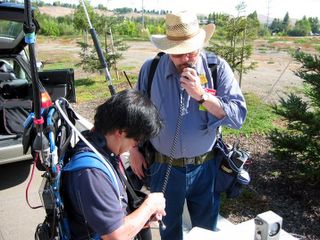The following is an extract from the RAC (Radio Amateurs of Canada) web site RAC Home Page
Welcome to the fascinating world of Amateur Radio!
Amateur radio is a form of communication; a hobby; a community service.It could be a school teacher in Nova Scotia making friends over the radio with another Radio Amateur in New Zealand; an Alberta teenager
using her computer to upload a chess move through her radio which is
retrieved by a fellow chess fan in Florida via an amateur radio space
satellite; or a truck driver in Manitoba contacting Radio Amateurs in a
hundred countries during a single weekend contest. Radio Amateurs also
save lives as part of an emergency communications network.
What do Amateur Radio operators do during and after disasters?
This unique mix of fun, convenience and public service is what
distinguishes Amateur Radio. People get involved in Amateur Radio for
many reasons, but they all have in common a basic knowledge of radio
technology, regulations and operating principles. All have passed an
examination leading to an authorization to operate on the "Amateur
Bands." These frequency bands are reserved for use by Radio
Amateurs at intervals from just above the AM broadcast band all the way
up through the microwave frequencies. Even though Amateur Radio
conversations may be heard around the world by anyone with a suitable
radio receiver, given the right frequency and propagation conditions,
Amateur Radio is basically two-way communication between Radio Amateurs.
The appeal of Amateur Radio is the ability to communicate across the country,
around the globe, and even with astronauts on space missions. Some
Radio Amateurs build and experiment with radio. Computer hobbyists
find digital modes to be a low-cost way to expand their ability to communicate.
Those with a competitive streak enjoy "DX contests" where the
object is to see how many distant Radio Amateurs they can contact.
Some like the convenience of a technology giving them portable
communication. Others use it to open the door to new friendships over the air,
or through participation in an Amateur Radio club. Many combine Amateur
Radio with the internet in various ways.
Typical Radio Amateurs come from all walks of life - lawyers, entertainers,
missionaries, doctors, ministers, politicians, students, workers, shut-ins and
retired folks - all ages, sexes, income levels and nationalities. Some like
voice communication on a hand-held radio. Others prefer Morse code
through a low-power transmitter. Many transmit computer messages through
amateur radio satellites. They all use radio to communicate with their
fellow Radio Amateurs.
What is the history of Amateur Radio in Canada?
In 1901, Marconi transmitted the Morse code letter "S" from
Poldhu in Wales to St. John's, Newfoundland. Soon
early radio experimenters were trying out the first "spark gap" transmitters.
To control interference to marine shore stations, Parliament passed the
Radiotelegraph Act in 1913. In 1914 the Radiotelegraph Regulations
were issued, prescribing the first operating and technical proficiency
examinations for Amateur Radio operators in Canada.Administered
by various government departments, Amateur Radio grew in Canada
to over 50,000 certificates at present.
How is Amateur Radio different from Citizens' Band or
Family Radio Service?These unlicensed services are legally limited to
voice operation over low powered equipment on a single frequency band.
Amateur Radio may involve voice, Morse code, computer data,
or television modes on any of a number of bands, either direct or via
repeater stations or earth-orbiting satellites, and may use considerable
power and directional antenna systems.
Why must Radio Amateurs pass an examination?
Although a major purpose of Amateur Radio is recreation, it is called
the "Amateur Radio Service" because it also has a serious
face. The government created this "Service" partly to fill the
need for a pool of experts who could provide communications in times of
emergency or war. Countless lives have been saved when these skilled
hobbyists acted as emergency communicators to render aid during or
following a hurricane, tornado, ice storm, earthquake or other disaster.
In addition, the government acknowledged the ability of Amateur Radio to
advance communication and technical skills, and to enhance international
goodwill.
The requirements for Amateur Radio operators in Canada
The Basic Qualification - is the entry-level
and does not require any Morse code test. To earn the Basic
Qualification requires passing an examination totalling 100 questions on
basic radio theory, regulations and operating practices.
The Basic Qualification with call sign gives authority to transmit
on all Amateur Radio bands above 30 megahertz, in all modes.
The Morse Code Qualification - To earn this,
one must pass a 5 Words Per Minute sending and receiving test.
Added to the Basic Qualification, this grants the holder access to
the bands (1.8 - 30 MHz) in all the modes permitted on those short wave bands.
The Advanced Qualification - To earn this requires passing a 50 question examination on radio theory. Added to the Basic Qualification this permits the holder to build transmitting equipment, operate high-powered transmitters, and to sponsor a voice repeater or club station.
One organization that many North American hams participate in, is the
American Radio Relay League. The American Radio Relay League
(or the ARRL as it is known) is an excellent organization providing
services for radio amateurs in the United States. To Learn more
about Amateur Radio and the ARRL, explore ARRL Web Site




